Gay multimedia artist Jim Hodges never met a material he couldn’t turn into art, as the DMA’s spectacular new exhibit proves

JEAN POOL | Jim Hodges’ exhibit at the DMA includes his most recent piece, completed just last month: a turbulent, windblown tapestry made entirely out of sewn denim fabric. (Arnold Wayne Jones/Dallas Voice)
ARNOLD WAYNE JONES | Life+Style Editor
Most artists dabble in one medium, maybe two: Watercolor, bronze, photography. But Jim Hodges seems to have never met a material he didn’t like — or couldn’t turn into a staggering piece of art.
It wasn’t always that way. Hodges started out as a painter, until a mentor told him he’d never be great at it. That emboldened him to explore artistic expression on his own terms, from count objects to site-specific pieces to tableaux that capture a moment but can also embody an era.
 The retrospective Jim Hodges: Give More Than You Take, at the Dallas Museum of Art through Jan. 12, brings together his magpie collection of pieces, curated with stunning vibrancy to highlight the scope and diversity of the artist’s work. It’s one of the best exhibitions in Dallas in a decade.
The retrospective Jim Hodges: Give More Than You Take, at the Dallas Museum of Art through Jan. 12, brings together his magpie collection of pieces, curated with stunning vibrancy to highlight the scope and diversity of the artist’s work. It’s one of the best exhibitions in Dallas in a decade.
Hodges continually plays with forms, which makes him impossible to pigeonhole. He was influenced by the AIDS crisis of the 1980s and ’90s, and you glean that looking askew at his subject matter: A panel of mirrored tiles conjures a flattened disco ball, a symbol perhaps of the end of the carefree days of Studio 54. Across the gallery sits What’s Left: a pile of clothes, tossed carelessly on the floor and draped with a “cobweb” (made of metal) suggesting the quickly discarded garb of a hookup that remained untouched after both men drifted away.
Webs and mirrors (sometimes combined) form one of the themes coursing through Hodges’ work — for instance Gate, which creates a negative space in front of which a metal “web” hangs, teasing us with the emptiness (illuminated with a peaceful but sterile cerulean light).
Gate is one of several pieces that feels site-specific, even if they are not, such as Changing Things, an arrangement of more than 300 pins and silk flowers stuck into the wall, forming a constellation of colors. You might actually pass by He and I and not recognize it as part of the exhibit: Faint pastel pencil drawings of two concentric circles, representing Hodges and his former partner.
Hodges’ style often sneaks up on you — literally. Metal webs hide in corners, and a black ski mask flits overhead like some still bat. (There’s an element of Duchamp in the found objects Hodges employs, though few of the pieces seem authentic ready-mades.) But the crowning piece, new to the DMA, grabs you: An immense landscape of denim the evokes Guernica in its size, power and turgid energy. Comparing Hodges to Picasso might seem like a stretch, but see the exhibit, and you’ll be hard-pressed to disagree. This is the unmissable art show of the year.
This article appeared in the Dallas Voice print edition October 25, 2013.

